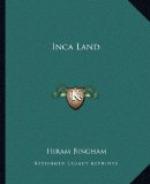Certainly the pass of La Raya, long the gateway from the Titicaca Basin to the important cities and towns of the Urubamba Basin, was the key to the situation. It is probable that Pachacuti VI drew up his army behind this wall. His men were undoubtedly armed with slings, the weapon most familiar to the highland shepherds. The invaders, however, carried bows and arrows, more effective arms, swifter, more difficult to see, less easy to dodge. As Pachacuti VI was carried over the field of battle on a golden stretcher, encouraging his men, he was killed by an arrow. His army was routed. Montesinos states that only five hundred escaped. Leaving behind their wounded, they fled to “Tampu-tocco,” a healthy place where there was a cave, in which they hid the precious body of their ruler. Most writers believe this to be at Paccaritampu where there are caves under an interesting carved rock. There is no place in Peru to-day which still bears the name of Tampu-tocco. To try and identify it with some of the ruins which do exist, and whose modern names are not found in the early Spanish writers, has been one of the principal objects of my expeditions to Peru, as will be described in subsequent chapters.
------ Figure
A Potato-field at La Raya ------
------ Figure
Laying Down the Warp for a Blanket: Near the Pass of La Raya ------
Near the watershed of La Raya we saw great flocks of sheep and alpacas, numerous corrals, and the thatched-roofed huts of herdsmen. The Quichua women are never idle. One often sees them engaged in the manufacture of textiles—shawls, girdles, ponchos, and blankets—on hand looms fastened to stakes driven into the ground. When tending flocks or walking along the road they are always winding or spinning yarn. Even the men and older children are sometimes thus engaged. The younger children, used as shepherds




